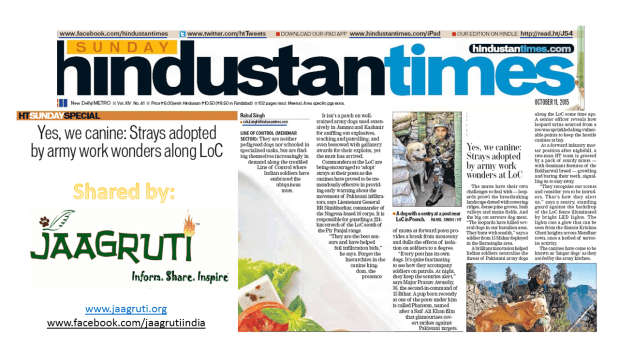We at JAAGRUTI had shared in our earlier posts, how police stations across Naxal infested regions of India have befriended street dogs in their near vicinity to help alert them to naxal attacks and impending danger, and now, we would like to share how these stray dogs are helping Indian army soldiers posted along the LoC (Line of Control) on the country’s high security border posts, foil infiltration bids and giving our soldiers much needed companionship in a hard terrain doing a hard job of protecting us all and our nation. This story was published on the Front page of The Hindustan Times dated 11th October 2015 and reading it made our day and gave vindication to what we have been saying all along, that these sturdy Indian stray dogs if looked after well, treated with compassion, sterilized and vaccinated by local community caretakers, can not only act as wonderful guard dogs but also help spread the spirit of compassion around in this increasing self and selfie-obsessed world; for love is all we and they need actually!
All photos and text are courtesy Journalist Rahul Singh of The Hindustan Times.
Original Link to the story as published in the newspaper can be accessed by clicking on: “Yes, we can-ine: How strays are foiling infiltration bids along LoC“
We thank HT and Rahul for reporting this heart-warming story, so beautifully.

A dog with a sentry at a post near LoC in Poonch_by Rahul Singh_HT_11102015
They are neither pedigreed dogs nor schooled in specialised tasks, but are finding themselves increasingly in demand along the troubled Line of Control where Indian soldiers have embraced the ubiquitous mutt.
It isn’t a patch on well-trained army dogs used extensively in Jammu and Kashmir for sniffing out explosives, tracking and patrolling — and even bestowed with gallantry awards for their exploits, yet the mutt has arrived.
Commanders at the LoC are being encouraged to ‘adopt’ strays at their posts as the canines have proved to be tremendously effective in providing early warning about the movement of Pakistani infiltrators, says Lieutenant General RR Nimbhorkar, commander of the Nagrota-based 16 corps. It is responsible for guarding a 224-km stretch of the LoC south of the Pir Panjal range.
“They are the best sensors and have helped foil infiltration bids,” he says. Forget the hierarchies in the canine kingdom, the presence of mutts at forward posts provides a break from monotony and dulls the effects of isolation on soldiers to a degree.

A dog with a sentry at a post near LoC in Poonch sector_by Rahul Singh_HT_11102015
A brilliant innovation helped Indian soldiers neutralise the threat of Pakistani army dogs along the LoC some time ago. A senior officer reveals how leopard urine sourced from a zoo was sprinkled along vulnerable points to keep the hostile canines at bay.
At a forward infantry mortar position after nightfall, a two-man HT team is greeted by a pack of sturdy mutts — with dominant features of the Bakharwal breed — growling and baring their teeth, signalling us to stay away.
“They recognise our scents and consider you to be intruders. That’s how they alert us,” says a sentry, standing guard against the backdrop of the LoC fence illuminated by bright LED lights. The lights cast a glow that can be seen from the distant Krishna Ghati heights across Mendhar town, once a hotbed of terrorist activity.
The canines have come to be known as ‘langar dogs’ as they are fed by the army kitchen.

